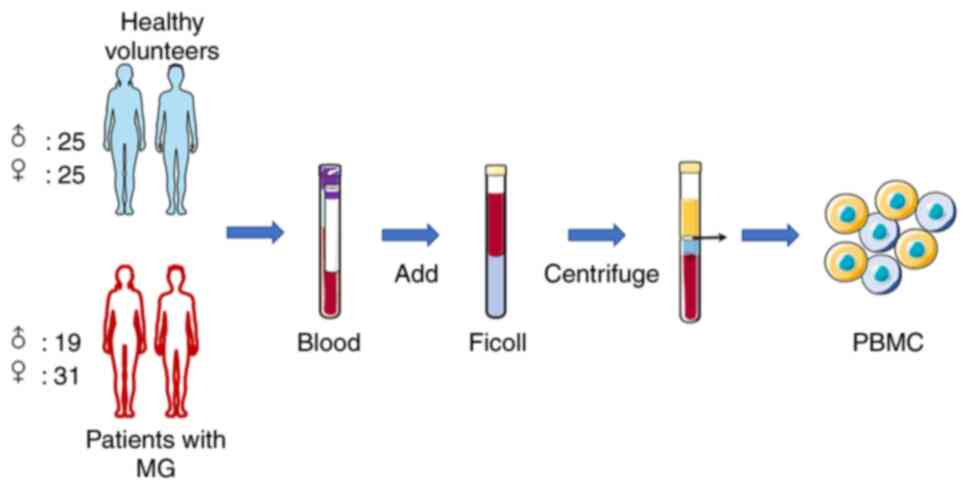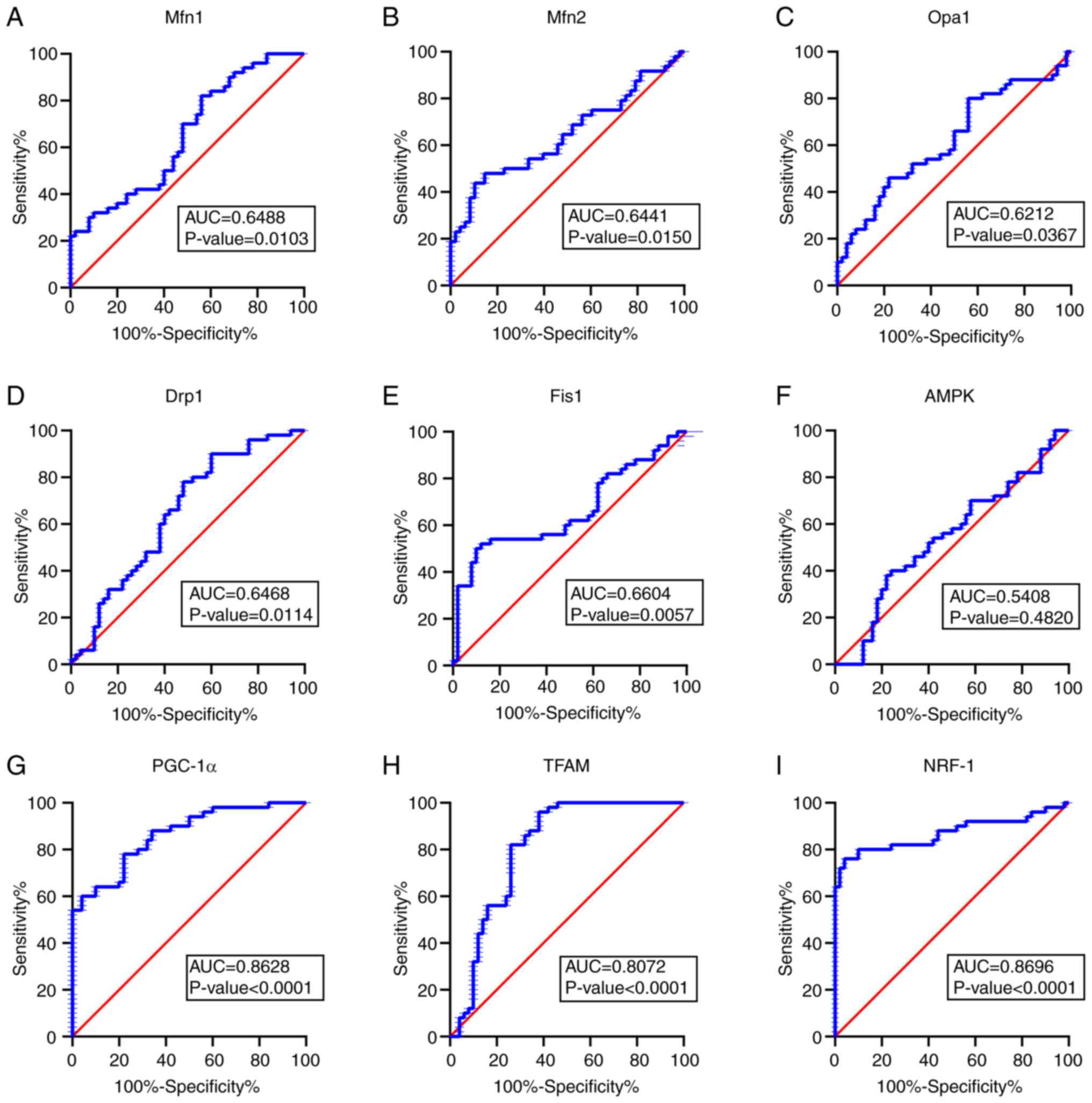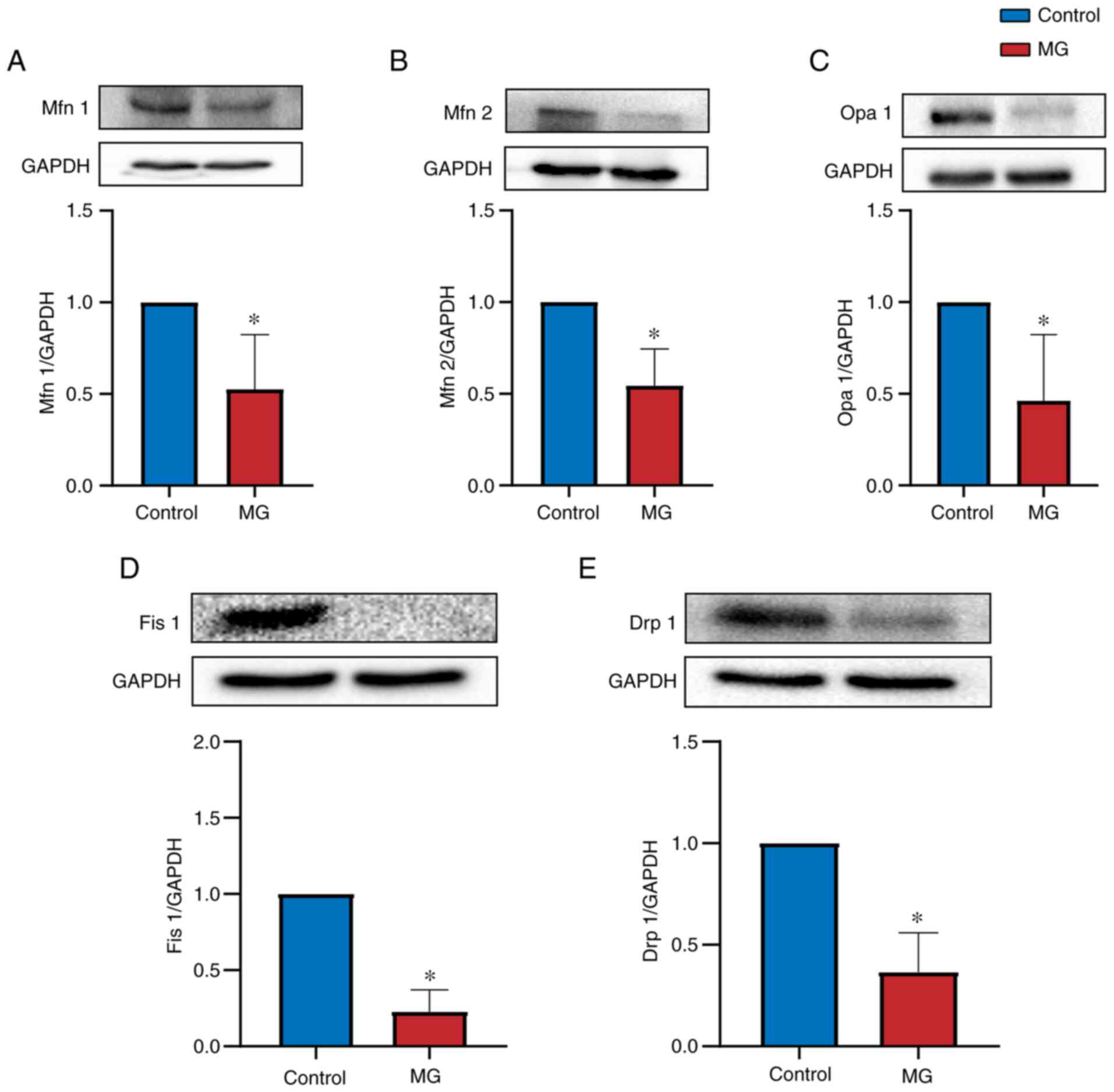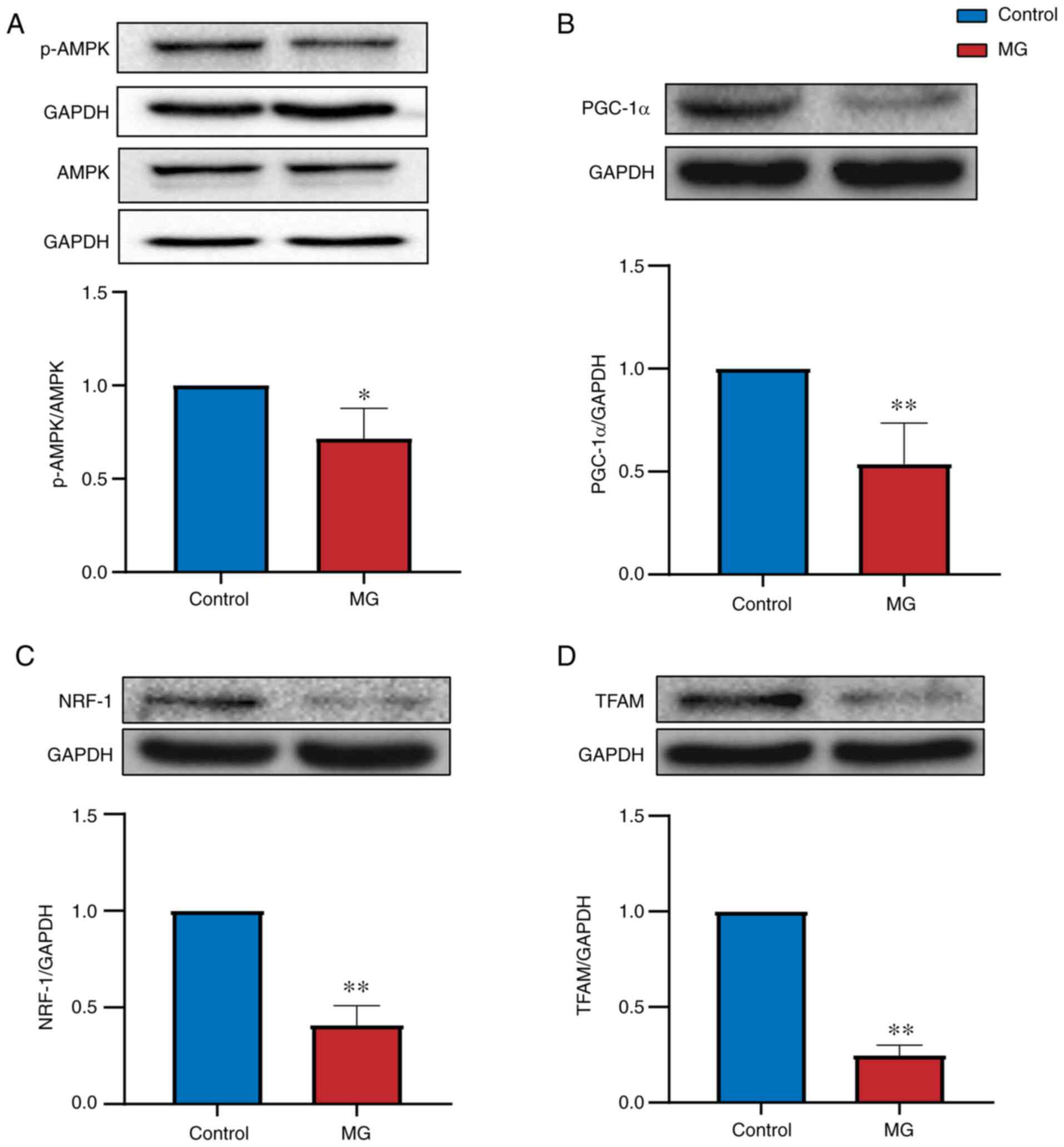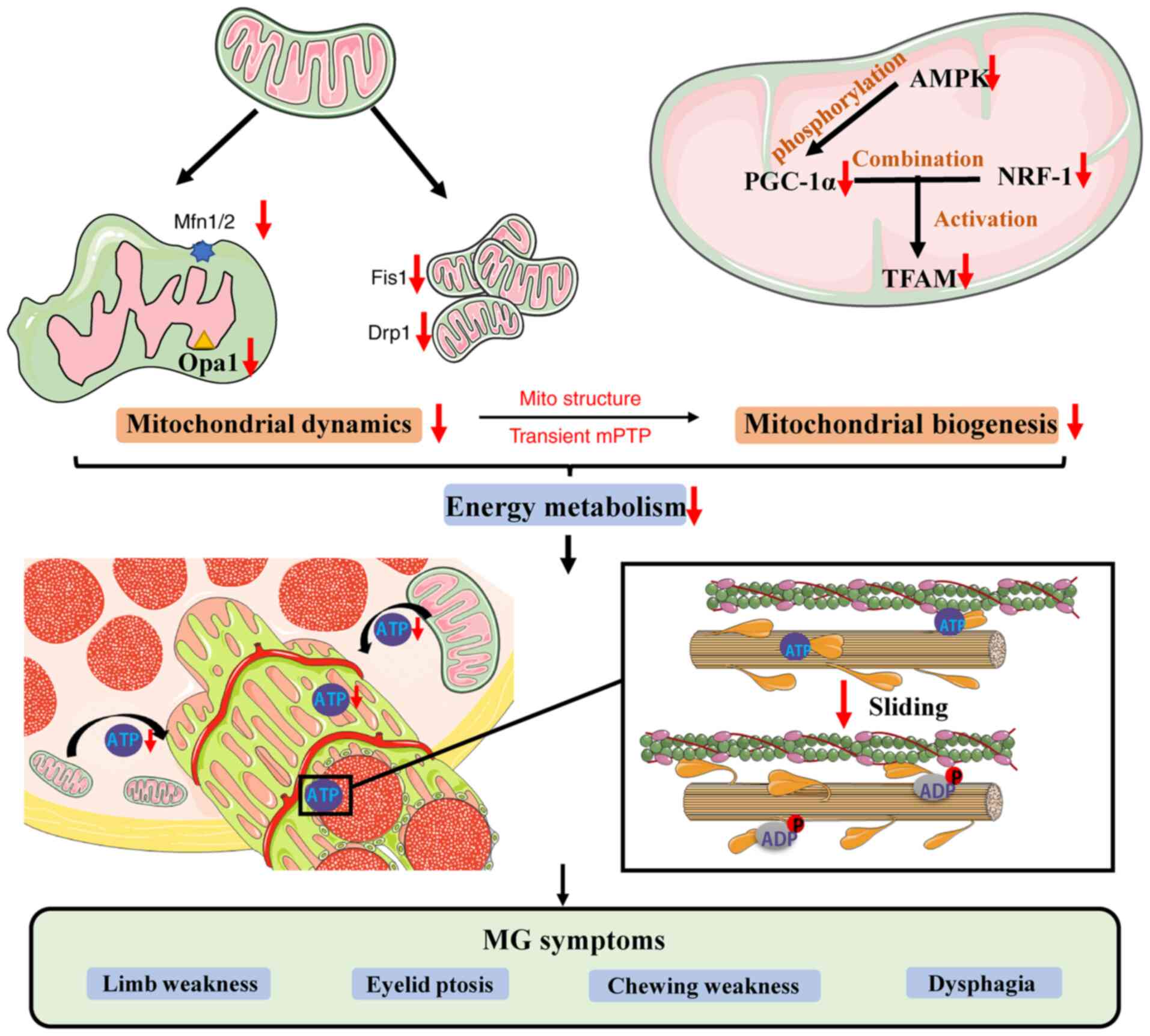|
1
|
Binks S, Vincent A and Palace J:
Myasthenia gravis: A clinical-immunological update. J Neurol.
263:826–834. 2016.PubMed/NCBI View Article : Google Scholar
|
|
2
|
Berrih-Aknin S, Frenkian-Cuvelier M and
Eymard B: Diagnostic and clinical classification of autoimmune
myasthenia gravis. J Autoimmun. 48-49:143–148. 2014.PubMed/NCBI View Article : Google Scholar
|
|
3
|
Hehir MK and Silvestri NJ: Generalized
myasthenia gravis: Classification, clinical presentation, natural
history, and epidemiology. Neurol Clin. 36:253–260. 2018.PubMed/NCBI View Article : Google Scholar
|
|
4
|
Sieb JP: Myasthenia gravis: An update for
the clinician. Clin Exp Immunol. 175:408–418. 2014.PubMed/NCBI View Article : Google Scholar
|
|
5
|
Szczudlik P, Sobieszczuk E, Szyluk B,
Lipowska M, Kubiszewska J and Kostera-Pruszczyk A: Determinants of
quality of life in myasthenia gravis patients. Front Neurol.
11(553626)2020.PubMed/NCBI View Article : Google Scholar
|
|
6
|
Mantegazza R and Cavalcante P: Diagnosis
and treatment of myasthenia gravis. Curr Opin Rheumatol.
31:623–633. 2019.PubMed/NCBI View Article : Google Scholar
|
|
7
|
Bastian TW, von Hohenberg WC, Georgieff MK
and Lanier LM: Chronic energy depletion due to iron deficiency
impairs dendritic mitochondrial motility during hippocampal neuron
development. J Neurosci. 39:802–813. 2019.PubMed/NCBI View Article : Google Scholar
|
|
8
|
Romanello V and Sandri M: Mitochondrial
quality control and muscle mass maintenance. Front Physiol.
6(422)2016.PubMed/NCBI View Article : Google Scholar
|
|
9
|
Meyer JN, Leuthner TC and Luz AL:
Mitochondrial fusion, fission, and mitochondrial toxicity.
Toxicology. 391:42–53. 2017.PubMed/NCBI View Article : Google Scholar
|
|
10
|
Fix DK, Hardee JP, Gao S, VanderVeen BN,
Velázquez KT and Carson JA: Role of gp130 in basal and
exercise-trained skeletal muscle mitochondrial quality control. J
Appl Physiol (1985). 124:1456–1470. 2018.PubMed/NCBI View Article : Google Scholar
|
|
11
|
Forrester SJ, Preston KJ, Cooper HA, Boyer
MJ, Escoto KM, Poltronetti AJ, Elliott KJ, Kuroda R, Miyao M,
Sesaki H, et al: Mitochondrial fission mediates endothelial
inflammation. Hypertension. 76:267–276. 2020.PubMed/NCBI View Article : Google Scholar
|
|
12
|
Chiong M, Cartes-Saavedra B,
Norambuena-Soto I, Mondaca-Ruff D, Morales PE, García-Miguel M and
Mellado R: Mitochondrial metabolism and the control of vascular
smooth muscle cell proliferation. Front Cell Dev Biol.
2(72)2014.PubMed/NCBI View Article : Google Scholar
|
|
13
|
Hu L, Ding M, Tang D, Gao E, Li C, Wang K,
Qi B, Qiu J, Zhao H, Chang P, et al: Targeting mitochondrial
dynamics by regulating Mfn2 for therapeutic intervention in
diabetic cardiomyopathy. Theranostics. 9:3687–3706. 2019.PubMed/NCBI View Article : Google Scholar
|
|
14
|
Gao Q, Wang XM, Ye HW, Yu Y, Kang PF, Wang
HJ, Guan SD and Li ZH: Changes in the expression of cardiac
mitofusin-2 in different stages of diabetes in rats. Mol Med Rep.
6:811–814. 2012.PubMed/NCBI View Article : Google Scholar
|
|
15
|
Li Y and Liu X: Novel insights into the
role of mitochondrial fusion and fission in cardiomyocyte apoptosis
induced by ischemia/reperfusion. J Cell Physiol. 233:5589–5597.
2018.PubMed/NCBI View Article : Google Scholar
|
|
16
|
Zhang M, Wu J, Sun R, Tao X, Wang X, Kang
Q, Wang H, Zhang L, Liu P, Zhang J, et al: SIRT5 deficiency
suppresses mitochondrial ATP production and promotes AMPK
activation in response to energy stress. PLoS One.
14(e0211796)2019.PubMed/NCBI View Article : Google Scholar
|
|
17
|
Wen JJ, Cummins CB, Szczesny B and
Radhakrishnan RS: Cardiac dysfunction after burn injury: Role of
the AMPK-SIRT1-PGC1α-NFE2L2-ARE Pathway. J Am Coll Surg.
230:562–571. 2020.PubMed/NCBI View Article : Google Scholar
|
|
18
|
Lv J, Bhatia M and Wang X: Roles of
mitochondrial DNA in energy metabolism. Adv Exp Med Biol.
1038:71–83. 2017.PubMed/NCBI View Article : Google Scholar
|
|
19
|
Zhao Q, Tian Z, Zhou G, Niu Q, Chen J, Li
P, Dong L, Xia T, Zhang S and Wang A: SIRT1-dependent mitochondrial
biogenesis supports therapeutic effects of resveratrol against
neurodevelopment damage by fluoride. Theranostics. 10:4822–4838.
2020.PubMed/NCBI View Article : Google Scholar
|
|
20
|
Araujo BG, Souza E, Silva LF, de Barros
Torresi JL, Siena A, Valerio BCO, Brito MD and Rosenstock TR:
Decreased mitochondrial function, biogenesis, and degradation in
peripheral blood mononuclear cells from amyotrophic lateral
sclerosis patients as a potential tool for biomarker research. Mol
Neurobiol. 57:5084–5102. 2020.PubMed/NCBI View Article : Google Scholar
|
|
21
|
Santacatterina F, Chamorro M, de Arenas
CN, Navarro C, Martín MA, Cuezva JM and Sánchez-Aragó M:
Quantitative analysis of proteins of metabolism by reverse phase
protein microarrays identifies potential biomarkers of rare
neuromuscular diseases. J Transl Med. 13(65)2015.PubMed/NCBI View Article : Google Scholar
|
|
22
|
Oh KH, Sheoran S, Richmond JE and Kim H:
Alcohol induces mitochondrial fragmentation and stress responses to
maintain normal muscle function in Caenorhabditis elegans.
FASEB J. 34:8204–8216. 2020.PubMed/NCBI View Article : Google Scholar
|
|
23
|
Sligar J, Debruin DA, Saner NJ, Philp AM
and Philp A: The importance of mitochondrial quality control for
maintaining skeletal muscle function across healthspan. Am J
Physiol Cell Physiol: Feb 2, 2022 (Epub ahead of print). doi:
10.1152/ajpcell.00388.2021.
|
|
24
|
Sanders DB, Wolfe GI, Benatar M, Evoli A,
Gilhus NE, Illa I, Kuntz N, Massey JM, Melms A, Murai H, et al:
International consensus guidance for management of myasthenia
gravis: Executive summary. Neurology. 87:419–425. 2016.PubMed/NCBI View Article : Google Scholar
|
|
25
|
Livak KJ and Schmittgen TD: Analysis of
relative gene expression data using real-time quantitative PCR and
the 2(-Delta Delta C(T)) method. Methods. 25:402–408.
2001.PubMed/NCBI View Article : Google Scholar
|
|
26
|
Anil R, Kumar A, Alaparthi S, Sharma A,
Nye JL, Roy B, O'Connor KC and Nowak RJ: Exploring outcomes and
characteristics of myasthenia gravis: Rationale, aims and design of
registry-The EXPLORE-MG registry. J Neurol Sci.
414(116830)2020.PubMed/NCBI View Article : Google Scholar
|
|
27
|
Park JS, Eah KY and Park JM:
Epidemiological profile of myasthenia gravis in South Korea using
the national health insurance database. Acta Neurol Scand: Feb 9,
2022 (Epub ahead of print). doi: 10.1111/ane.13596.
|
|
28
|
Zou M, Liu Z, Zhang XS and Wang Y:
NCC-AUC: An AUC optimization method to identify multi-biomarker
panel for cancer prognosis from genomic and clinical data.
Bioinformatics. 31:3330–3338. 2015.PubMed/NCBI View Article : Google Scholar
|
|
29
|
Zhang S, Ding JH, Zhou F, Wang ZY, Zhou XQ
and Hu G: Iptakalim ameliorates MPP + -induced astrocyte
mitochondrial dysfunction by increasing mitochondrial complex
activity besides opening mitoK(ATP) channels. J Neurosci Res.
87:1230–1239. 2009.PubMed/NCBI View Article : Google Scholar
|
|
30
|
Shally A and McDonagh B: The redox
environment and mitochondrial dysfunction in age-related skeletal
muscle atrophy. Biogerontology. 21:461–473. 2020.PubMed/NCBI View Article : Google Scholar
|
|
31
|
Powers JD, Malingen SA, Regnier M and
Daniel TL: The sliding filament theory since Andrew Huxley:
Multiscale and multidisciplinary muscle research. Annu Rev Biophys.
50:373–400. 2021.PubMed/NCBI View Article : Google Scholar
|
|
32
|
Ruiter AM, Verschuuren JJGM and Tannemaat
MR: Fatigue in patients with myasthenia gravis. A systematic review
of the literature. Neuromuscul Disord. 30:631–639. 2020.PubMed/NCBI View Article : Google Scholar
|
|
33
|
Ke L, Li Q, Song J, Jiao W, Ji A, Chen T,
Pan H and Song Y: The mitochondrial biogenesis signaling pathway is
a potential therapeutic target for myasthenia gravis via energy
metabolism (Review). Exp Ther Med. 22(702)2021.PubMed/NCBI View Article : Google Scholar
|
|
34
|
Rautenbach RM, Pillay K, Murray ADN and
Heckmann JM: Extraocular muscle findings in myasthenia gravis
associated treatment-resistant ophthalmoplegia. J Neuroophthalmol.
37:414–417. 2017.PubMed/NCBI View Article : Google Scholar
|
|
35
|
Vila MC, Rayavarapu S, Hogarth MW, Van der
Meulen JH, Horn A, Defour A, Takeda S, Brown KJ, Hathout Y,
Nagaraju K and Jaiswal JK: Mitochondria mediate cell membrane
repair and contribute to Duchenne muscular dystrophy. Cell Death
Differ. 24:330–342. 2017.PubMed/NCBI View Article : Google Scholar
|
|
36
|
Gilhus NE: Myasthenia Gravis. N Engl J
Med. 375:2570–2581. 2016.PubMed/NCBI View Article : Google Scholar
|
|
37
|
Punga AR, Maddison P, Heckmann JM, Guptill
JT and Evoli A: Epidemiology, diagnostics, and biomarkers of
autoimmune neuromuscular junction disorders. Lancet Neurol.
21:176–188. 2022.PubMed/NCBI View Article : Google Scholar
|
|
38
|
Smith VM, Nguyen H, Rumsey JW, Long CJ,
Shuler ML and Hickman JJ: A Functional Human-on-a-Chip autoimmune
disease model of myasthenia gravis for development of therapeutics.
Front Cell Dev Biol. 9(745897)2021.PubMed/NCBI View Article : Google Scholar
|
|
39
|
White AJ, Wijeyekoon RS, Scott KM,
Gunawardana NP, Hayat S, Solim IH, McMahon HT, Barker RA and
Williams-Gray CH: The Peripheral Inflammatory Response to
Alpha-Synuclein and Endotoxin in Parkinson's Disease. Front Neurol.
9(946)2018.PubMed/NCBI View Article : Google Scholar
|
|
40
|
Yalçınkaya N, Haytural H, Bilgiç B,
Özdemir Ö, Hanağası H, Küçükali Cİ, Özbek Z, Akcan U, İdrisoğlu HA,
Gürvit H and Tüzün E: Expression changes of genes associated with
apoptosis and survival processes in Parkinson's disease. Neurosci
Lett. 615:72–77. 2016.PubMed/NCBI View Article : Google Scholar
|
|
41
|
Ding Q, Qi Y and Tsang SY: Mitochondrial
biogenesis, mitochondrial dynamics, and mitophagy in the maturation
of cardiomyocytes. Cells. 10(2463)2021.PubMed/NCBI View Article : Google Scholar
|
|
42
|
Ahmed ME, Selvakumar GP, Kempuraj D,
Thangavel R, Mentor S, Dubova I, Raikwar SP, Zaheer S, Iyer S and
Zaheer A: Synergy in disruption of mitochondrial dynamics by Aβ
(1-42) and glia maturation factor (GMF) in SH-SY5Y cells is
mediated through alterations in fission and fusion proteins. Mol
Neurobiol. 56:6964–6975. 2019.PubMed/NCBI View Article : Google Scholar
|
|
43
|
Gao J, Zhao L, Wang J, Zhang L, Zhou D, Qu
J, Wang H, Yin M, Hong J and Zhao W: C-Phycocyanin ameliorates
mitochondrial fission and fusion dynamics in ischemic cardiomyocyte
damage. Front Pharmacol. 10(733)2019.PubMed/NCBI View Article : Google Scholar
|
|
44
|
Zhang Q, Guo D and Wang Y, Wang X, Wang Q,
Wu Y, Li C, Wang W and Wang Y: Danqi pill protects against heart
failure post-acute myocardial infarction via HIF-1α/PGC-1α mediated
glucose metabolism pathway. Front Pharmacol. 11(458)2020.PubMed/NCBI View Article : Google Scholar
|
|
45
|
Iqbal S and Hood DA: The role of
mitochondrial fusion and fission in skeletal muscle function and
dysfunction. Front Biosci (Landmark Ed). 20:157–172.
2015.PubMed/NCBI View
Article : Google Scholar
|
|
46
|
Santel A, Frank S, Gaume B, Herrler M,
Youle RJ and Fuller MT: Mitofusin-1 protein is a generally
expressed mediator of mitochondrial fusion in mammalian cells. J
Cell Sci. 116:2763–2774. 2003.PubMed/NCBI View Article : Google Scholar
|
|
47
|
Fix DK, VanderVeen BN, Counts BR and
Carson JA: Regulation of skeletal muscle DRP-1 and FIS-1 protein
expression by IL-6 signaling. Oxid Med Cell Longev.
2019(8908457)2019.PubMed/NCBI View Article : Google Scholar
|
|
48
|
Eisenhut P, Mebrahtu A, Moradi Barzadd M,
Thalén N, Klanert G, Weinguny M, Sandegren A, Su C, Hatton D, Borth
N and Rockberg J: Systematic use of synthetic 5'-UTR RNA structures
to tune protein translation improves yield and quality of complex
proteins in mammalian cell factories. Nucleic Acids Res.
48(e119)2020.PubMed/NCBI View Article : Google Scholar
|
|
49
|
Mayr C: Regulation by 3'-Untranslated
Regions. Annu Rev Genet. 51:171–194. 2017.PubMed/NCBI View Article : Google Scholar
|
|
50
|
Prats AC, David F, Diallo LH, Roussel E,
Tatin F, Garmy-Susini B and Lacazette E: Circular RNA, the key for
translation. Int J Mol Sci. 21(8591)2020.PubMed/NCBI View Article : Google Scholar
|
|
51
|
Cortassa S, Aon MA, Winslow RL and
O'Rourke B: A mitochondrial oscillator dependent on reactive oxygen
species. Biophys J. 87:2060–2073. 2004.PubMed/NCBI View Article : Google Scholar
|
|
52
|
Reutzel M, Grewal R, Dilberger B, Silaidos
C, Joppe A and Eckert GP: Cerebral mitochondrial function and
cognitive performance during aging: A longitudinal study in NMRI
mice. Oxid Med Cell Longev. 2020(4060769)2020.PubMed/NCBI View Article : Google Scholar
|
|
53
|
Xiang Z, Valenza M, Cui L, Leoni V, Jeong
HK, Brilli E, Zhang J, Peng Q, Duan W, Reeves SA, et al:
Peroxisome-proliferator-activated receptor gamma coactivator 1 α
contributes to dysmyelination in experimental models of
Huntington's disease. J Neurosci. 31:9544–9553. 2011.PubMed/NCBI View Article : Google Scholar
|
|
54
|
Jones AW, Yao Z, Vicencio JM,
Karkucinska-Wieckowska A and Szabadkai G: PGC-1 family coactivators
and cell fate: Roles in cancer, neurodegeneration, cardiovascular
disease and retrograde mitochondria-nucleus signalling.
Mitochondrion. 12:86–99. 2012.PubMed/NCBI View Article : Google Scholar
|
|
55
|
Martín-Jiménez R, Lurette O and
Hebert-Chatelain E: Damage in mitochondrial DNA associated with
Parkinson's Disease. DNA Cell Biol. 39:1421–1430. 2020.PubMed/NCBI View Article : Google Scholar
|
|
56
|
Islam H, Bonafiglia JT, Turnbull PC,
Simpson CA, Perry CGR and Gurd BJ: The impact of acute and chronic
exercise on Nrf2 expression in relation to markers of mitochondrial
biogenesis in human skeletal muscle. Eur J Appl Physiol.
120:149–160. 2020.PubMed/NCBI View Article : Google Scholar
|
|
57
|
Piao Y, Kim HG, Oh MS and Pak YK:
Overexpression of TFAM, NRF-1 and myr-AKT protects the
MPP(+)-induced mitochondrial dysfunctions in neuronal cells.
Biochim Biophys Acta. 1820:577–585. 2012.PubMed/NCBI View Article : Google Scholar
|
|
58
|
Ramachandran B, Yu G and Gulick T: Nuclear
respiratory factor 1 controls myocyte enhancer factor 2A
transcription to provide a mechanism for coordinate expression of
respiratory chain subunits. J Biol Chem. 283:11935–11946.
2008.PubMed/NCBI View Article : Google Scholar
|
|
59
|
Song J, Lei X, Jiao W, Song Y, Chen W, Li
J and Chen Z: Effect of Qiangji Jianli decoction on mitochondrial
respiratory chain activity and expression of mitochondrial fusion
and fission proteins in myasthenia gravis rats. Sci Rep.
8(8623)2018.PubMed/NCBI View Article : Google Scholar
|
|
60
|
Jiao W, Hu F, Li J, Song J, Liang J, Li L,
Song Y, Chen Z, Li Q and Ke L: Qiangji Jianli Decoction promotes
mitochondrial biogenesis in skeletal muscle of myasthenia gravis
rats via AMPK/PGC-1α signaling pathway. Biomed Pharmacother.
129(110482)2020.PubMed/NCBI View Article : Google Scholar
|















